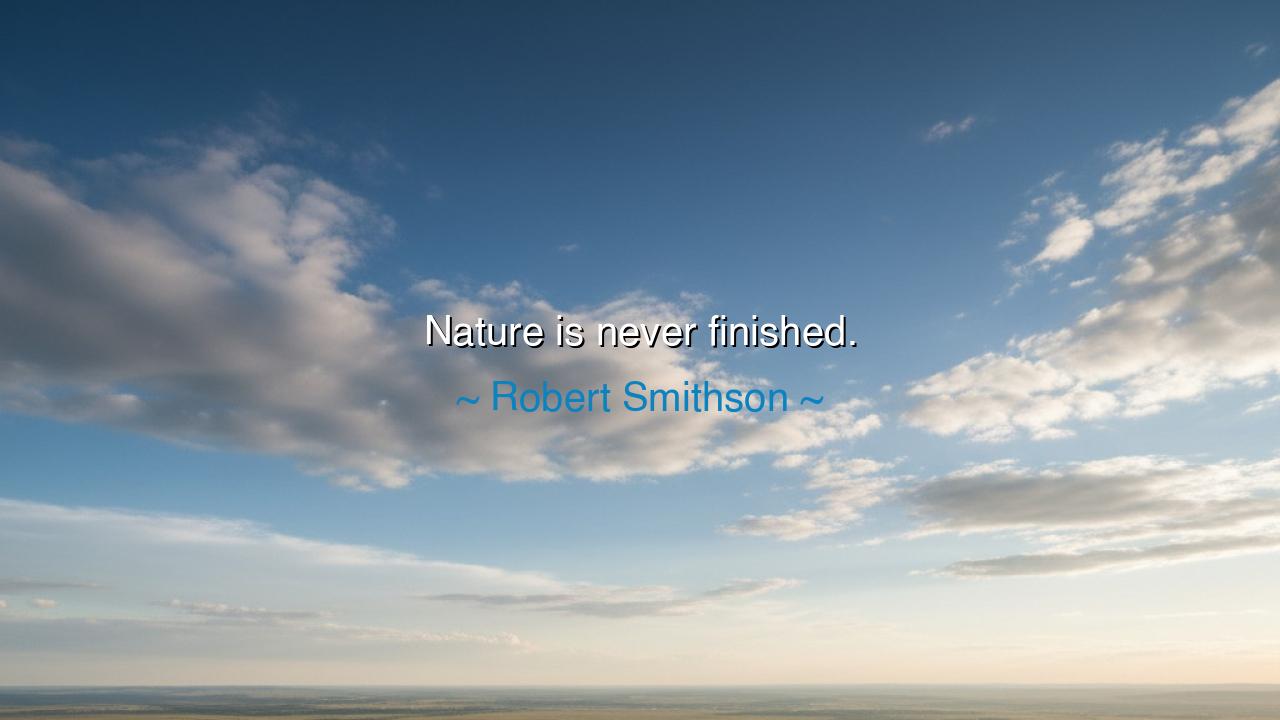
Nature is never finished.






Hear now, O seekers of wisdom, the words of Robert Smithson, the sculptor of earth and stone, who declared: “Nature is never finished.” These words are as vast as the sea, as endless as the horizon. They remind us that the world is not a statue carved once and for all, but a living symphony, ever changing, ever unfolding. What we see before us—the mountains, the rivers, the forests, the deserts—are not final works, but chapters in an eternal story, whose last page shall never be written.
Consider the mountains. To the eye they stand eternal, yet the wise know they are rising, crumbling, shifting under the slow dance of the earth’s crust. Valleys are carved by rivers that flow for ages, cliffs are worn by winds that never rest. A tree grows, falls, and feeds the soil from which new life springs. Even death itself in nature is not an ending, but a turning of the wheel. The saying reminds us that change is the heartbeat of existence, and to resist it is to resist life itself.
Think on the tale of Pompeii, the ancient city laid low by the wrath of Vesuvius. Once buried in ash, it seemed destroyed, silenced for eternity. And yet, over centuries, nature wove her hand upon the ruins—vines creeping over stone, animals making shelter where once men dwelled, the land reshaping itself with quiet persistence. Even in catastrophe, nature did not end, but transformed. What appeared as final was only a pause in her endless song.
And remember too the works of Smithson himself, who shaped the Spiral Jetty upon the Great Salt Lake. He knew, as he laid stone upon stone, that the waters would rise, would cover, would erode, and then reveal again. His art was not fixed, but surrendered to the living will of nature. In this surrender lay the deeper truth: that our creations, too, are part of the unfinished canvas of the earth. What we build will be altered, absorbed, and remade by the greater hand of time.
This saying is not only about the land and sea, but about our own lives. We too are never finished. The heart that beats in us is shaped by seasons—youth, maturity, old age—and even in death, we return to the cycle, becoming earth again, nourishing what comes after. The trials you face, the wounds you bear, the triumphs you claim—all are moments in the unfinished story of your soul. To despair in difficulty is to forget that nothing ends; all things are reshaped, reformed, reborn.
Take this teaching as your guide: do not seek a final perfection, for in nature none exists. Seek instead to walk with change, to see beauty in becoming. When your work feels incomplete, remember that incompleteness is the law of life. When your path seems broken, recall that rivers too carve new channels. When your heart aches with endings, trust that endings are only transformations. Nature is never finished, and neither are you.
Therefore, let your actions be like seeds. Plant trees knowing they will outlive you. Create works that may weather and change. Live in harmony with the unfinished, for this is where life’s sacred rhythm lies. Do not fear that all is fleeting, but rejoice that all is flowing. The permanence you seek is not in stillness but in the ceaseless unfolding of creation.
So I say unto you: walk humbly upon the earth, knowing that her story continues long after your footprints fade. See in the rising sun, in the shifting tide, in the growing child, the living truth of Smithson’s words: “Nature is never finished.” For in this endlessness lies both our challenge and our hope, a reminder that though all things change, the song of life never ceases.






AAdministratorAdministrator
Welcome, honored guests. Please leave a comment, we will respond soon